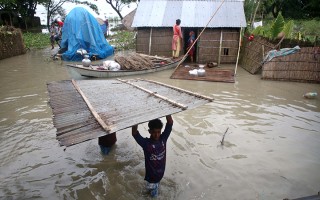Bangladesh faces longest flooding in 2 decades
The ongoing flood has already become the longest flood in the last 22 years as it continues to wreak havoc in Bangladesh after 32 days and there is no sign of it to subside in the next 15 days.
The last time flood duration crossed 30-day threshold was in 1998, when 68 per cent of Bangladesh went under water by a flood that lasted 66 days, according to the Flood Forecasting and Warning Centre.
The ongoing flood already engulfed more than 35 per cent of the country with the possibility of it extending further to reach around 40 per cent area by the time it started to recede in the 2nd week of August.
‘We are witnessing the deadliest flood so far this century,’ Institute of Water and Flood Management professor at BUET AKM Saiful Islam told New Age.
After 1998, two floods with similar magnitude hit Bangladesh, causing about 40 per cent inundation in 2007 and 2017, according to FFWC.
But the floods were relatively short lived as they stayed less than 20 days.
Severity of flood is directly related to its duration, for the longer the flood the greater its damage.
Erosion could get severe in longer floods, especially when onrush of water continued from upstream throughout its duration as experienced this year.
A prolonged flooding severely disrupts normal rural economic life, leaves crop fields completely destroyed and subsequently give rise to fodder crisis because of destruction of vast grassland.
Bangladesh is no stranger to flooding as it drains over three fourths of 1.7 million square kilometres of the Ganges-Brahmaputra-Meghna river basins but floods became deadlier lately.
Five of the ten floods causing 30 per cent or above inundation since 1954 occurred in last two decades after 1998. Three of them occurred in the last four years. However, the longest flood occurred in 2012 lasting for 28 days.
‘While higher than usual monsoon precipitation produced more water than before to worsen the recent floods, poor water management was no less responsible for making them linger long,’ said Saiful.
He said that Bangladesh did nothing to put in place a mechanism to deal with 1 billion tonnes of silt the rivers carry along every year.
He also added that encroachment went on unabated and structures were built without caring about the rivers, trapping a huge volume of sediment over the years, causing rivers to spill more water than ever before.
Continued river encroachment also constricted channels through which water is supposed to drain into the sea, he said.
Currently, 17 rivers were flowing above their danger levels at 27 places across Bangladesh and the Teesta had flowed 50-year high on July 14.
The flood already killed 129 people since June 30 and destroyed crops over 1.50 lakh hectares already.
Over 200 km of embankment also got destroyed and over 14,000 houses were lost to erosion in the Rangpur division alone.
The government said that a complete assessment of losses caused by the ongoing flood would not be available until it came to an end.
Meteorologists Abdul Mannan said that a strange weather phenomenon could prolong the flood. ‘There was no monsoon low this year, let alone depressions,’ said Mannan.
He said that breaks in monsoon rain come because of this weather phenomenon known as monsoon depression, minimum three of which were due in the month of July.
He also added that this monsoon arrived earlier than usual just on the heels of super cyclone Amphan, which brought along a huge volume of rain late May.
‘By mid-June soil got saturated and water bodies almost filled to the brim and a long-term flood became obvious,’ said Mannan.
In May, Bangladesh had 17 per cent excess rain than normal, 2 per cent above normal in June while July got normal amount of rain a week before the month was over, according to the Bangladesh Meteorological Department.
A similar trend in rainfall was observed in upstream and floods were wreaking havoc in China, India, Nepal and Bhutan, which constitute 93 per cent of the Ganges-Brahmaputra-Meghna basin.
Meteorologists said that there was a continuous supply of moist air from the Bay of Bengal to cause almost ceaseless heavy rains through the first two months of the monsoon.
Rashed Chowdhury, a principal research scientist of Pacific ENSO Applications Centre at University of Hawaii, USA, said that this year’s flood would last longer than any normal year as the onset of La Nina is late this year.
He explained that La Nina develops by May-June and reaches its peak by July-August but this year’s La Nina was still in the developing stage would take more time to reach its peak.
‘When La Nina formation is delayed it could lead to heavy rains while leaving the sea at higher than usual level slowing river draining,’ said Rashed.
News Courtesy: www.newagebd.net











